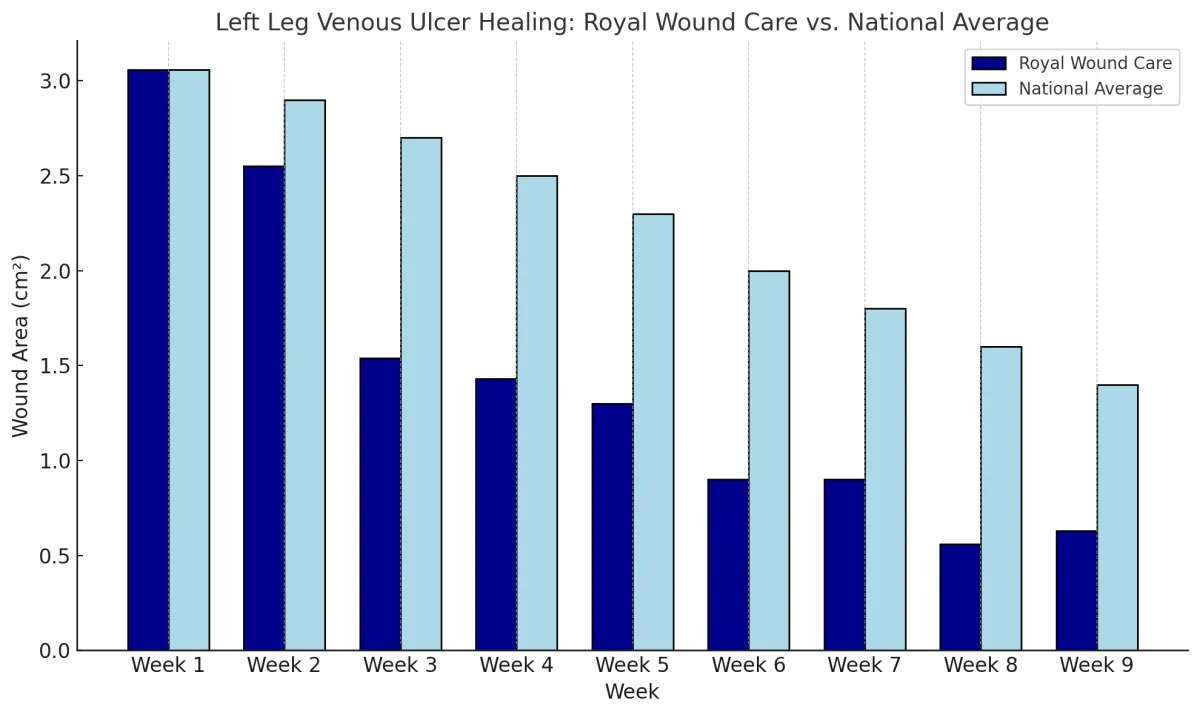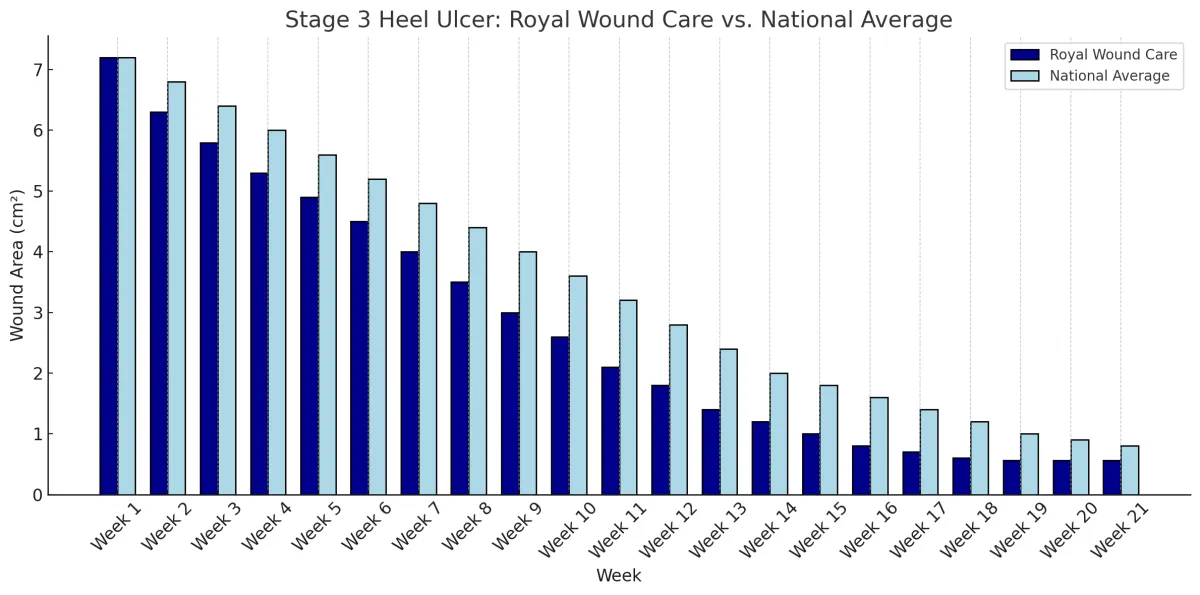Nursing Home Wound Care Management: Partnering with Royal Wound Care
From Diagnosis to Recovery—We’re With You Every Step of the Way
At every stage of the healing process—from initial diagnosis to full recovery—our dedicated wound care team delivers expert, compassionate support tailored to the needs of skilled nursing facility (SNF) residents. We specialize in providing a seamless, patient-centered continuum of care that ensures consistent, high-quality treatment throughout each resident’s journey to healing.
Our Skilled Nursing services include:
Skilled Observation and Assessment
Regular monitoring and evaluation of your health to ensure proper care and early detection of changes.
Diabetic Management
Expert guidance in managing diabetes, including blood sugar monitoring and insulin management.
Wound Care
Specialized care for wound healing, including dressing changes and infection prevention.
Medication Supervision
Assistance in managing medications and ensuring proper dosages and schedules.
Intravenous Therapy
Administering IV treatments such as hydration and antibiotics safely at home.
Total Parenteral Nutrition (TPN)
Providing nutritional support for patients unable to eat or absorb food normally.
Pain Management
Developing personalized pain control strategies to enhance comfort and quality of life.
Respiratory Treatment
Managing and supporting respiratory conditions with appropriate therapies.Incontinence Care
Helping with personal care and providing strategies for managing incontinence.
Catheter and Ostomy Care
Expert care for catheter and ostomy patients to ensure comfort and proper function.
Patient and Family Health Education
Offering training and guidance to ensure patients and families are equipped to manage ongoing care needs.
For questions regarding our skilled nursing facilities, please contact 818–660–2977


Clinical Excellence,Faster Healing, Better Outcomes: How Royal Wound Care Outperforms National Benchmarks
At Royal Wound Care, we deliver results that consistently outperform the national average. Our advanced healing process combines evidence-based treatments, personalized care plans, and direct physician oversight to ensure optimal outcomes. Unlike many clinics, every patient is managed by a board-certified wound care physician who evaluates their condition and customizes treatment from day one.
Our venous ulcer graph highlights our success in treating one of the most challenging chronic wounds. Venous ulcers are often slow to heal and prone to recurrence, but at Royal Wound Care, we address not only the wound itself but also its underlying causes. Through vascular assessments, compression therapy, advanced grafts, and customized treatment protocols, our patients consistently heal faster than those receiving standard care elsewhere. This comprehensive, physician-led approach results in better long-term outcomes and fewer hospitalizations.
Our Stage 3 heel ulcer graph demonstrates how our approach leads to significantly faster healing compared to the national average. While traditional care results in gradual wound size reduction over several months, patients treated at Royal Wound Care experience more rapid progress through targeted therapies, aggressive infection control, and ongoing physician-directed adjustments to their care plan. Our proactive methods allow us to close even complex wounds weeks earlier than national trends, improving patient mobility, reducing pain, and preventing further complications.
For more expert tips, insights, and updates on wound care, check out our blog.

Effective Chronic Wound Care Strategies
Preventing Complications in Chronic Wound Care: A Clinical Approach
Chronic wounds are complicated and have many causes. They need more than just simple care. These wounds heal slowly, which makes patients more likely to get infections, need hospital care, and develop long-term issues. Every year in the United States, millions of people face the problem of chronic wounds. This is especially true for those who have diabetes, peripheral arterial disease, or trouble moving around.
A planned and careful way to treat patients is very important for getting good results. This approach is based on strong evidence and follows guidelines from National Institutes of Health. From getting the right diagnosis to helping wound healing, every step matters. Using advanced treatment options like hyperbaric oxygen therapy and surgical intervention is also key. All of these steps help to make things better and reduce problems.
Related: Experts in Wound Care
Understanding the Risk Landscape
Most chronic wounds start as open wounds that don’t heal normally. A good physical examination is the first step to find out the type of wound, its underlying cause, and the right treatment plan. Doctors need to check not just the wound bed, but also the surrounding skin, the edges of the wound, and look for signs of infection, inflammation, or dead tissue.
Risk factors that can delay wound closure include low blood flow, foreign bodies in the wound, chronic pain, malnutrition, and biofilm development. Sometimes, systemic signs like an elevated erythrocyte sedimentation rate can show a deeper infection or an inflammatory reaction. This situation may need more intense treatment.
Chronic Wound Care
Effective management of chronic wounds begins with figuring out what type of wound it is. It could be a pressure ulcer, diabetic foot ulcer, venous leg ulcer, or another type of chronic wound. A wound care specialist might do a physical examination. They may also run lab tests and use imaging, like magnetic resonance scans. This is to check for problems like infection, low blood flow, or issues with soft tissue.
Standard wound care involves several steps. It includes local wound care, daily dressing changes, and keeping the area safe from moisture or further injury. Choosing the right wound dressing is very important. It should consider the moisture level, how many bacteria are present, and where the wound site is located.

Wound Care Complications
Common problems in wound care can hurt the healing process and the well-being of people. Infections are a big worry. You can tell if there is an infection because the wound site may look red, feel warm, swell, and have pus. It is very important to clean wounds well and change dressings often to stop infections. Too much fluid, called exudate, can slow healing. It can also cause maceration, which makes the skin around the wound soften and break down.
Delayed wound healing can happen because of several reasons. These include health problems like diabetes or vascular diseases, not eating well, and smoking. Healthcare providers must quickly deal with these problems to stop the wound from getting worse. Also, not following care plans or not removing dead tissue with surgical debridement can make things worse.
To reduce these problems, healthcare workers should check the wound often. They need to look for signs of infection or too much fluid. Treatment plans should be suited to each person's needs. Teaching proper wound care techniques and making changes to lifestyle may also help to improve healing results.
If conservative methods do not work, surgery may be needed. This includes surgical intervention like skin grafts or cleaning the area in the operating room. A vascular surgeon should be consulted if blood flow is poor because of peripheral arterial disease.
Preventing Wound Infection
Infection prevention is very important in healthcare. It needs careful attention to hygiene, wound care, and patient education. Keeping wounds clean is key to preventing infections. This can be done using sterile techniques and the right antimicrobial dressings when needed. It is also important to remove any sources of contamination or trauma. These things can make it harder for wounds to heal and raise the chance of infections.
Patient education is a big part of infection prevention. It helps people learn how to care for wounds and how to spot signs of infection early. This can lead to better results and fewer complications. Healthcare workers need to keep up with the latest evidence-based practices. This helps them give the best care and limit the spread of infectious diseases in healthcare settings.
When signs of infection show up, like pain, warmth, pus, or a rapid increase in wound size, it's important to get diagnosed and treated with antibiotics quickly. Signs like high white blood cells and leukocytosis can help with this. Also, using oxygen therapy, especially hyperbaric oxygen therapy, can bring oxygen to damaged tissue and help your immune cells work better.

Clinical Wound Management
Clinical wound management is a complete process. It includes several parts, like getting the wound bed ready and looking at overall health facts. This includes things like blood sugar levels, nutrition, and blood flow. With this all-inclusive method, healthcare workers focus on improving the environment for wound healing and stopping any problems from happening.
One effective way to manage wounds is negative pressure wound therapy (NPWT). This method has shown it works well to help new tissue grow and remove excess fluid. NPWT uses a special dressing and vacuum system to apply controlled negative pressure to the wound site. This setup helps improve blood flow, decrease swelling, and create a good environment for healing tissue.
Advanced wound care treatments like NPWT are very important. Other methods, such as bioengineered skin substitutes, hyperbaric oxygen therapy, and compression therapy, also help in healing wounds and preventing infections. When healthcare providers mix these treatments with careful wound evaluation, regular checks, and patient education, they can get better results. This approach improves the quality of life for people with chronic or complex wounds.
Growth-modulating agents, like growth factors, can be used to help speed up healing in wounds that are not improving. It's important to adjust care based on the overall health of the patient. This is especially true for complicated cases involving leg ulcers, a weakened immune system, or skin cancers near the wound area.
Related: Mobile Wound Care Services
How to Prevent Chronic Wound Complications
Preventing wounds and injuries begins with spotting risk factors early and providing proper wound care consistently. It's important to focus on the health of blood vessels, improve blood flow, and avoid putting pressure on weak areas for too long. Using methods like pressure redistribution surfaces, offloading footwear, and raising limbs are helpful ways to reduce the chances of getting wounds or injuries.
To stay healthy, you should take preventive actions and live a good lifestyle. This means regular exercise, eating a balanced diet, and drinking enough water. These habits can help your blood vessels stay healthy. It's also important to watch for any changes in your skin or how it feels. This is especially true for people at high risk, like those with diabetes or those who cannot move around easily. Catching these changes early can help with treatment.
Educating people about self-care is really important. This includes taking good care of your feet and checking your skin regularly. When individuals know how to look after themselves, it can stop small wounds from turning into serious problems. By spreading awareness and taking steps to prevent issues early, we can reduce the number of wounds. This helps improve health outcomes for everyone.
Clinicians need to teach patients and their caregivers how to watch for signs that their health is getting worse. They should also explain why it is important to stick to scheduled care routines. A care team that has good knowledge can step in before problems become serious.

Best Practices in Chronic Wound Care
Best practices in caring for chronic wounds focus on uniform procedures, regular training, and using new therapies backed by evidence. A systematic review supports these approaches. This includes:
Correctly staging wounds
Taking photos for records
Regularly checking progress
Working together as a team
Every patient should be seen as a whole person. Things like diet, other health problems, the medications they take, and their mental health can all affect how well they heal.
Signs of Infected Chronic Wounds
Detecting infections quickly is very important to stop serious health issues. The sooner we catch them, the better. There are several signs to look out for. These signs include bad smells, warmth in the area, swelling, yellow or green liquids, and wounds that aren't healing even with treatment. In more serious infections, people might feel feverish, tired, and could have high numbers of white blood cells or a higher erythrocyte sedimentation rate (ESR).
Infections can show different signs based on how serious they are and where they are in the body. For example, skin infections might make the area red and sore, along with other symptoms. On the other hand, respiratory infections may lead to coughing, trouble breathing, and pain in the chest.
Infections are serious and should not be ignored. They can spread fast and cause dangerous problems if not treated. It is important to see a doctor as soon as you notice any signs of infection. This helps in getting the right care and managing it effectively.
If you see these signs, it is important to get checked right away. Imaging, like magnetic resonance, can help find abscesses or osteomyelitis. In complicated cases, you might need to see a wound specialist or use resources from the department of health.

Wound Care Protocols for Nurses
Nurses are very important in giving care for chronic wounds. They help put wound care plans into action. This includes making sure daily dressing changes and hygiene practices happen the right way. They also follow procedures if more help is needed. Their careful watch is vital in spotting any problems or worsening of the wound site quickly.
Nurses do more than follow protocols. They also teach patients about caring for their wounds. This includes advice on eating well, staying active, and sticking to their medications to help them heal properly. Nurses team up with other health professionals to create care plans for each patient. These plans are designed to meet the specific needs of the patient. They also keep a close eye on how patients are doing. This way, they can make changes if needed to improve the results.
Nurses play an important role as advocates for their patients. They make sure patients get the right care when they need it. They work closely with other healthcare workers to look into the issues that might slow down wound healing. Their kindness and skills in assessing and treating wounds are key to helping patients feel more comfortable. This work also helps improve their quality of life and health, especially in chronic wound care settings.
Using the right methods for caring for open wounds is important. You should use direct contact dressings and work closely with wound specialists. This helps keep the care consistent. The steps you follow should also handle chronic pain, keep areas clean, and record healing progress over a long time.
Related: Find Advanced Wound Care
Conclusion
Preventing problems in chronic wound care needs more than just treating the wound after issues arise. It requires team effort, catching problems early, teaching patients, and having access to basic and advanced care options. When healthcare providers create a plan that fits the specific needs of the wound and the patient, they can lower complication rates. This approach helps promote long-term healing, even in the most complicated cases.
Ready for Advanced Wound Care?
If you or someone close to you has a wound that won’t heal, don’t try random solutions. Rely on the only board-certified wound care facility in the area—Royal Wound Care. Our team includes experts who use the latest therapies and advanced tests. We create personalized treatment plans to help wounds heal and avoid problems.
Are you looking for real solutions to chronic wounds?
Make an appointment today to see how expert wound care can help you.
👉 Schedule Now | Royal Wound Care | Caring for you with proven results in wound care.
Frequently Asked Questions
What are the signs that a wound is becoming chronic?
Stubborn wounds that don't improve or heal in four weeks may become chronic wounds. If you see any signs of infection, such as pain, reddening, swelling, or pus, you need to see a doctor quickly.
How often should a chronic wound be reassessed?
It is important to look at chronic wounds often to help improve patient outcomes. How often you check the wound depends on its state and how well the treatment is working. Usually, a healthcare worker should examine the wound at least once every one to two weeks, or follow specific instructions.
WEST HILLS
7230 Medical Center Dr. Suite 100
West Hills, CA 91307
(818)–660–2977
BEVERLY HILLS
9735 Wilshare Blvd #210B
Beverly Hills, CA 90212
(818)–660–2977
If you are interested in making an appointment, please click here to find a Wound Care Center near you.
Request an Appointment at a Royal Wound Care Facility near you.
Royal Wound Care is the expert in wound healing. Our board-certified wound care specialists are ready to help you begin your healing journey. Click the button below to request an appointment at a Wound Care Center near you—no referral needed
© 2025 Royal Wound Care, LLC. All rights reserved.
site by Growth Partners Marketing

